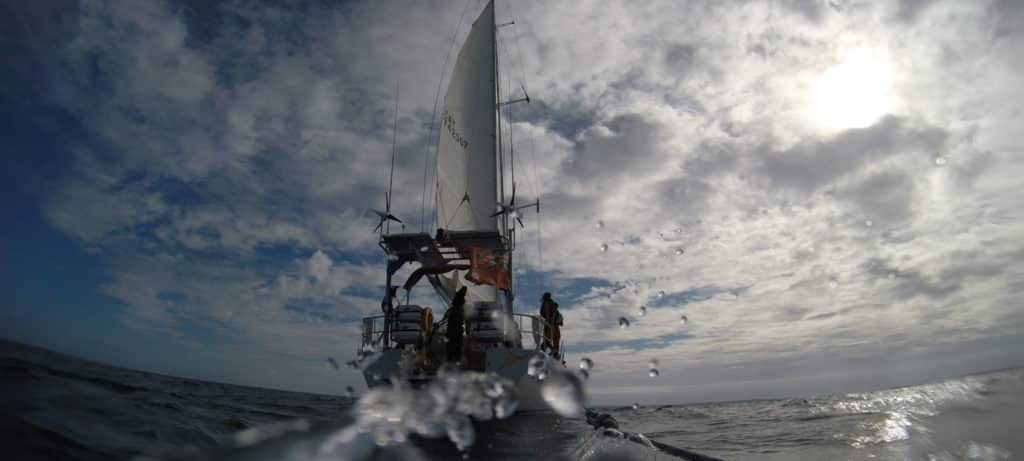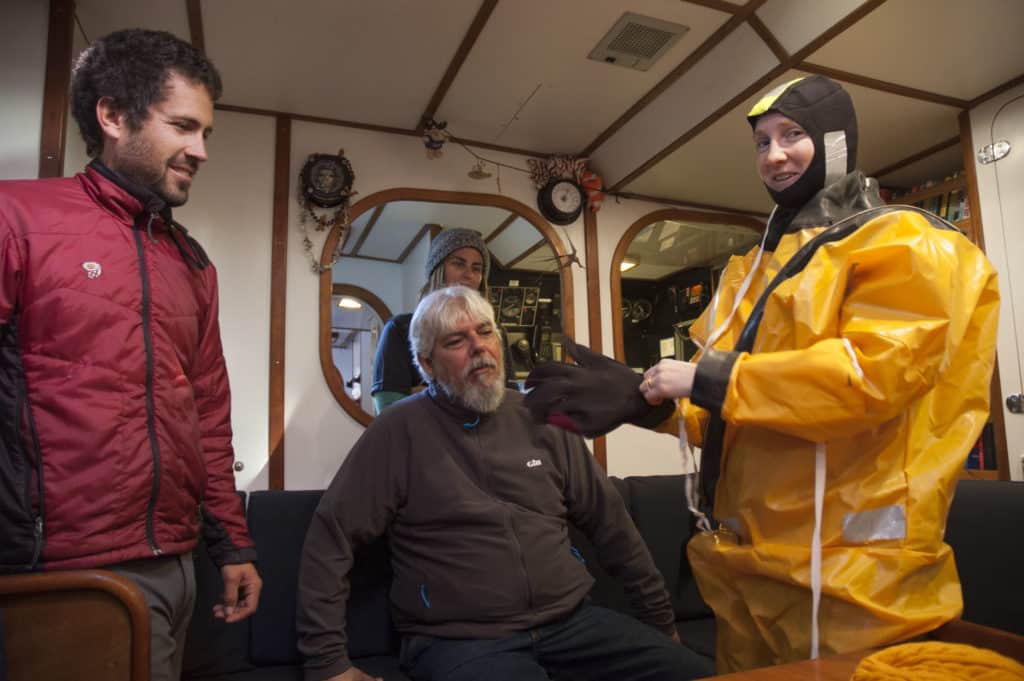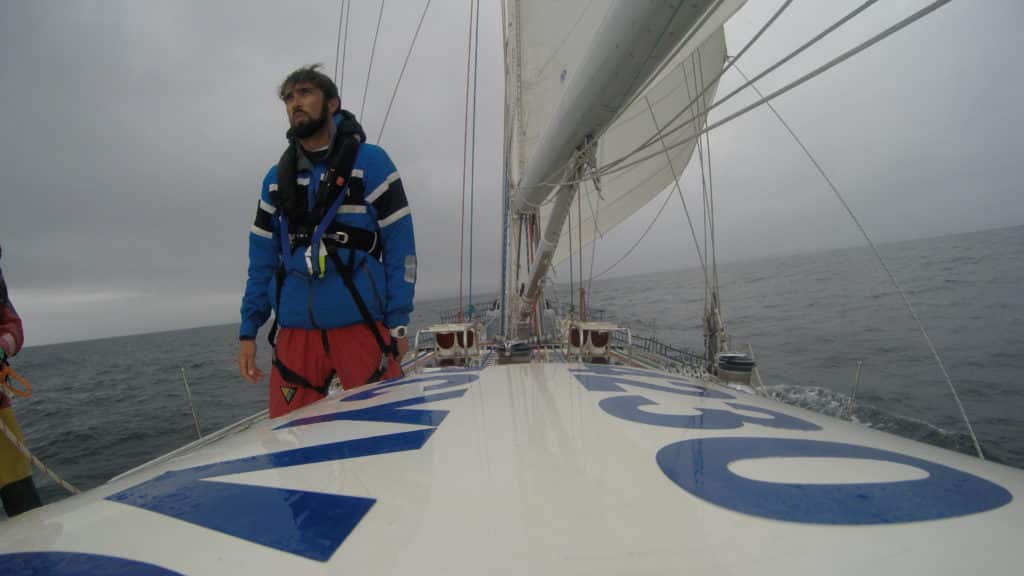
Click here for Part 1 of this story.
Thursday our southerly route had us on a beam reach in small but sloppy seas and 18 knots of wind. When we made it to the Cape Cod Canal, Pei, whose stomach had still not fully settled, was particularly excited to reach flat water.
Entering Buzzard’s Bay from the canal, the breeze piped up to the mid-20s with gusts in the low 30s, but we were out of the ocean swells. I’ve heard people talk about champagne sailing, and for the short dash from the canal to Woods Hole, just under an hour, I got to experience it. Close-reaching in 23 knots, we were gliding across the water doing 11. It was absolutely beautiful! Pei was at the wheel, with Eric coaching him on what to do with the channel markers and how to find the right amount of heel. I found a new favorite spot to wedge myself, to leeward of the instrument panel just behind the traveler and forward of the aft cockpit.
Then, just like that, we were dropping sails to anchor in Hadley Harbor, across the channel from Woods Hole. It was still blowing in the 20s, so we decided not to try to launch the dinghy or go for a swim. Now in our fifth night aboard Sea Dragon, we finally felt like we were in the groove of living and working as a crew. At dinner, the mood was congenial, the banter, lively. Today, I thought. Today is why I love sailing.
Friday we were expecting to wake up to rain but the squalls had gone through overnight and it was sunny, clear and the wind had died to almost nothing. Shanley, Eric, Pei, Lauren and I jumped in. The water was brisk for the pre-breakfast dip, but not nearly as cold as we had all psyched ourselves up for. We got out, lathered with a bit of Dr. Bronner’s soap and then jumped back in. It felt colder the second time! We rinsed with the freshwater hose and drip-dried in the cockpit while finishing coffees and teas. Steve made an incredible round of tangerine-and-mango smoothies.

Conditions for our passage to Block Island on Friday were calm, so we rigged up the ship’s manta trawl on a bridle to tow behind the boat. Eric told us about the science Pangaea Exploration conducts. The bulk of the research the ship has done involves collecting water samples and trawling for micro- and nano-plastics in the North Pacific, North Atlantic, South Atlantic and South Pacific gyres. He told us that plastic debris is swept by the currents into the major low-pressure areas of the oceans, and these areas therefore have a greater density of plastic than elsewhere. Over time, the plastic floating in the water column (most commonly within about a foot of the surface) is degraded by UV rays from the sun and breaks down into smaller and smaller pieces.
Shanley, who studied environmental science and policy in college, said that the trash found in the North Atlantic is primarily fishing gear — buoys, nets and fenders — while in the North Pacific it’s mostly domestic waste: refrigerators, food wrappers and shoes. The manta trawl that Sea Dragon tows is a funnel-shaped net that has a really fine mesh at the end to collect plastic fragments. She showed us glass tubes filled with plastic debris they had collected on some of their voyages.
Since we wouldn’t be sending samples from this particular trawl to a lab for analysis, we towed the gear from Sea Dragon‘s stern, but for precise readings the trawl is usually rigged on the end of a spinnaker pole to escape the turbulence of the boat’s wake. Even though we weren’t transiting one of the great oceanic gyres, our half-hour trawl gathered a handful of visible white, green and blue plastic bits, along with several jellyfish and a few pieces of seaweed.
Approaching Block Island, Shanley called the harbor master, who advised we head for New Harbor, also known as Great Salt Pond, because it would be better protected than Old Harbor from the gale we were anticipating. At 1700, the weather was getting more serious, with heavy rain, poor visibility and increasing gusts. We struck the main and added extra sail ties, and bagged up the staysail and stowed it below before we tied up to the dock in New Harbor at 1730. We found ourselves next to a crew filming a teen thriller on a fishing boat. Ours were the only two boats in the harbor.
The crew rigged extra dock lines, fenders and chafe gear because the barometer had dropped 11 millibars over the previous night and then another 12 during the day. Wind was on its way!

Weather kept us pinned on Block Island for a day. At dawn the harbor was deserted except for the teen-thriller crew, who were drinking whiskey and jumping off the dock. They had wrapped up filming sometime in the early hours and had been celebrating since. They reappeared a few hours later, looking like the dead and begging for seasickness medications for their ferry ride home.
The wind built throughout the day as we explored town, the island’s petting zoo and the library. We played a rousing game of darts at the Yellow Kittens bar and then braved the blustery 20-minute walk back to the boat. Pei had bought a game called In a Pickle for 25 cents at the library, and we played it over dinner.
Sunday morning, we got up with the intention of leaving around lunchtime to take advantage of the high tide. A few of us walked out to the breakwater to check the conditions and were greeted by gnarly chop and wind still in the 20s. The lowest sounder reading we’d seen on our way into the harbor had been a little over 3 feet under the 11-foot-deep keel; these swells were definitely more than 3 feet. Sea Dragon wouldn’t be going anywhere on the noon tide.
Upon returning to the boat, Eric relayed the conditions and the decision to stay put for another day. The delay cost us three crewmembers, whom we hugged goodbye as they left for the ferry.
Eric, Shanley, Tom and I spent one more day hiking around Block Island, and watched the sunset with hot toddies on the porch of the Spring House hotel.
A walk to the breakwater Monday morning revealed good enough conditions for us to make the jump over to Newport. The wind had dropped to the high teens, and the swell had calmed considerably. Bearing off toward Narragansett Bay as we rounded the northern end of the island, we were making over 8 knots under jib alone. Did I mention this boat was fast? We were on a mooring in Newport by noon.
So, we didn’t make it to Bermuda. But we had a fantastic coastal cruise. All in all, it had been one hell of a boogie.
Pangaea Exploration runs expeditions focused on marine exploration, education and conservation aboard Sea Dragon, a Challenge 72, all over the world. Sailors can book individual legs, or groups can sign up for specialized voyages focused on scientific research, filmmaking or sail training. Sea Dragon is a versatile platform for scientists and has often been used for studying marine debris, collecting water samples and conducting wide-ranging dive missions. Upcoming trips include an exploration of northwestern Africa, a transatlantic from the Canaries to the Caribbean, and some extended voyaging into the heart of the Pacific. Find out more at panexplore.com.
– – –
Eleanor Merrill is CW‘s managing editor.








